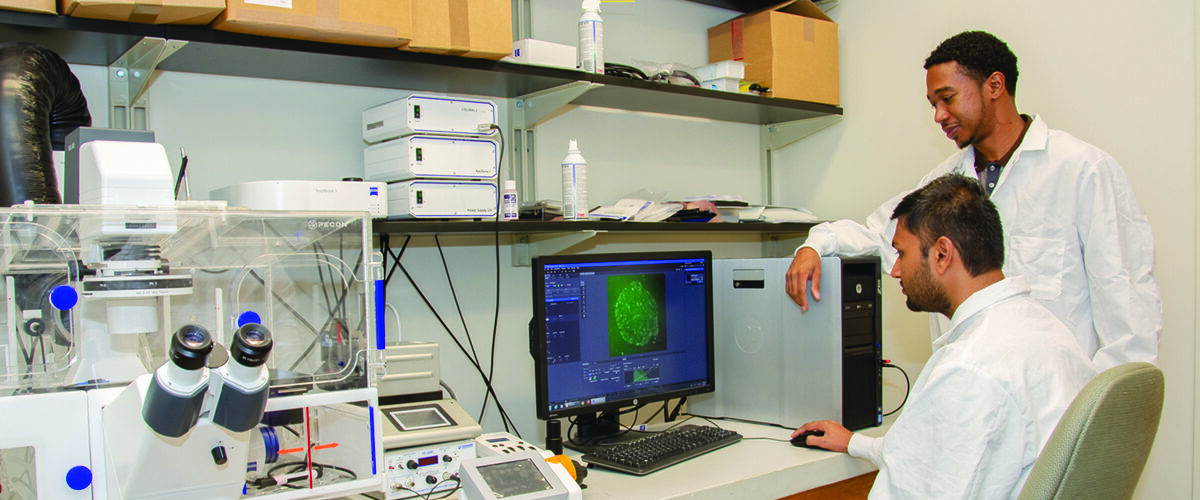What do your car and the cells within your body have in common? They each have their own mechanical system. A UCF College of Medicine and Engineering and Computer Science researcher just received a grant worth almost $1 million from the National Institutes of Health to decipher how mechanical forces in your cells can cause heart disease.
Robert Steward Jr. will investigate the early stages of the heart disease called atherosclerosis. He will use his mechanical and biomedical engineering expertise to examine whether bad cholesterol and white blood cells enter the heart’s vessels at mechanically weak locations in the heart with a goal of creating therapies to treat or prevent such mechanical weaknesses.
“As an engineer, you’re trained to identify a problem, build the technology to solve that problem and use that technology to critically analyze the problem,” Steward said. “It’s incredibly meaningful when you can use that training to contribute to human health.”
Steward joined the Colleges of Medicine and Engineering and Computer Sciences in 2015. He received his Ph.D. in mechanical engineering at Carnegie Mellon, did postdoctoral training at Harvard’s T.H. Chan School of Public Health and loves to build Lego models in his spare time.
“I view the cell as a mechanical system that generates and responds to mechanical forces. Understanding how mechanical forces influence human health and utilizing these finding to cure and prevent disease is what drives my research,” he said.
“As an engineer, you’re trained to identify a problem, build the technology to solve that problem and use that technology to critically analyze the problem. It’s incredibly meaningful when you can use that training to contribute to human health.” -Robert Steward
The Mechanics of Cells
Cells use mechanical forces to attach themselves to each other and to surrounding tissues throughout the body, he explained. Skin is a perfect example of how the body needs mechanics to stay intact and working. Metastatic cancer cells have their own “scary” mechanics that allow them to spread quickly throughout the body, he added, which explains in part how they spread from a primary tumor to organs like the brain and lungs.
He uses an automated fluorescent microscope coupled with complex mathematical algorithms to see, model and calculate the mechanical forces generated by cells. This high-tech system allows him to determine the mechanical “weak” and “strong” points within a group of cells.
Scientists know the early stages of atherosclerosis is characterized by the excessive deposition and penetration of bad cholesterol and white blood cells into the blood vessels of the heart. If left unchecked, atherosclerotic plaques can form and completely block these blood vessels, causing a heart attack or stroke. If Steward can find figure out how the mechanics work, he may also be able to figure out a way to outsmart the process and prevent this kind of heart disease.

Collaboration to Combat Heart Disease
The NIH grant totals $738,000 for five years and is designed to support scientists without a traditional background in biology or medicine who are focusing their efforts to solve health problems.
As part of the grant, Steward will work with Sampath Parthasarathy, the medical school’s associate dean for research. He discovered a major finding in cardiac science: how bad cholesterol blocks arterial vessels in the heart. The two will collaborate to determine the link between cell-derived mechanical forces and cardiovascular disease.
Parthasarathy has been a strong advocate for interdisciplinary research, noting that different scientific perspectives are a key to solving medicine’s unanswered questions. He helped develop UCF’s new master’s degree in biomedical engineering, which links education and research efforts from the College of Engineering and Computer Science and the College of Medicine.
“What we see as a wall, engineers see as gates,” Parthasarathy said. “And they can show us how to open those gates.”
Such collaboration is a reason Steward came to UCF. He was drawn by the opportunity to work with the many leaders in disease at the College of Medicine’s Burnett School of Biomedical Sciences and offer an engineer’s perspective on why cells do what they do.
“At Harvard I worked on the medical campus and had the opportunity to collaborate with clinicians on a routine basis,” he said. “Working with a strong group of talented collaborators here at UCF opens so many opportunities.”
